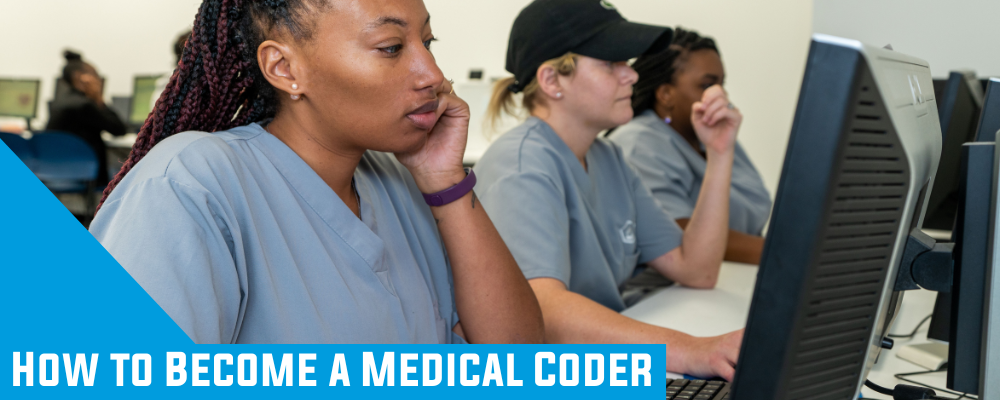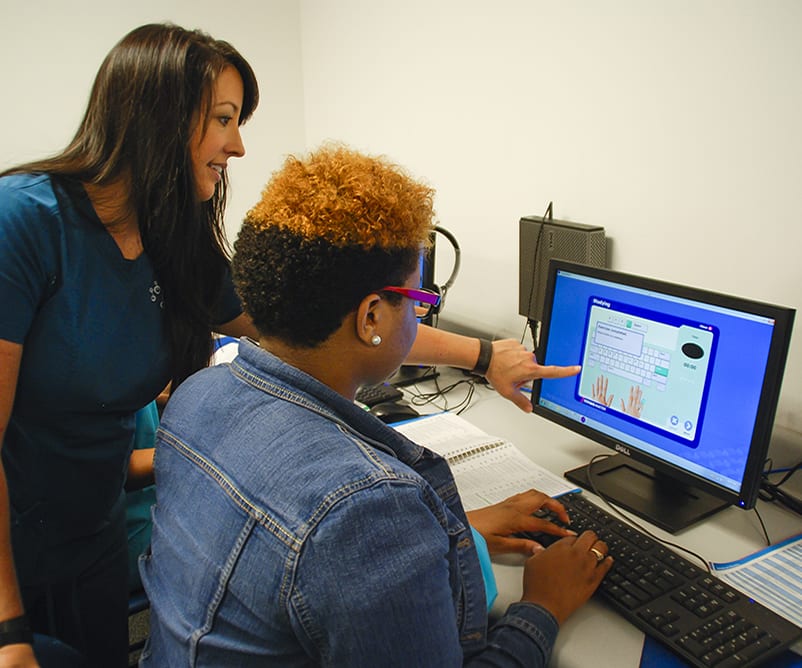Are you interested in becoming a medical coder? These allied health specialists, also known as Medical Records and Health Information Specialists, are essential to healthcare infrastructure, as they’re responsible for updating patient records required for data management and billing purposes within medical settings.
The Bureau of Labor Statistics (BLS) lists one of the primary responsibilities of medical coders as translating doctors’ notes and medical information into code. These medical codes are used to bill insurance companies and are stored in the Center for Disease Control (CDC)’s database.
If you’ve always imagined yourself working in healthcare and enjoy working with technology, training to become a medical coder may be a great option for you. If so, this article breaks down the career path and provides specific details on how to start your medical coding training.
What Is Medical Coding?
Medical coding is an allied health profession. Allied health professionals are people who work in the health profession, but are not doctors, nurses, or dentists.
Medical coders review documentation from doctors and medical professionals and are an essential part of the medical field. Medical coding is used to translate diseases, injuries, and procedures into numerical designations or codes electronically to create medical records for billing and information purposes.
Most medical coders will work in general practice offices and translate a broad range of information, while other medical coders will specialize in certain specific areas of coding, like creating cancer registries. For example, medical coders who choose to work on cancer registries may require additional training and certifications.
Why Are Medical Coders Necessary?
Medical coders play a huge role in the internal workings of most doctors’ offices and medical facilities. Medical coding helps to streamline illness reporting and is also helpful for tracking disease prevalence and effective treatments.
The Center for Disease Control (CDC) regulates medical codes, which are uniform among medical facilities to allow data to be transferred efficiently across the U.S. Medical coding is also sent to insurance companies for billing and payment purposes.
Interested in Learning More About Medical Coding?
Fill out the form below to receive info about our career training programs.
How Long Does It Take To Become A Medical Coder?
Becoming a medical coder can take anywhere from 9 months to several years, depending on the type of training you pursue. For example, the BLS notes that most medical coders need some level of postsecondary education, such as a certificate, diploma, or degree, but others may only need a high school diploma.
Is Medical Coding Hard To Learn?
Medical coding can be challenging to learn. However, with the right training, hard work, and dedication, earning your medical coding diploma and starting a career in medical coding is possible!
There are several different categories of complex codes that must be learned during training to become a medical coder, including:
- International Classification of Diseases (ICD) is a code that represents doctors’ diagnoses and patients’ conditions. Created by the World Health Organization (WHO) in the 1940s, the code has been updated several times.
- As of 2016, the medical industry is using version ICD-10-CM, which stands for International Classification of Diseases Tenth Revision Clinical Modification. The clinical modification (CM) is a batch of revisions implemented by the National Center for Health Statistics (NCHS), which allows coders to have more flexibility and be more specific within their reporting. ICD-10-CM codes are used to help to determine acceptable treatment based on previous occurrences on other patients and the history of the illness around the U.S.
- The Current Procedure Terminology (CPT) is a procedure code set that represents most of the medical procedures that occur in a physician’s office. Regulated by the American Medical Association (AMA) and updated annually, the CPT includes five-digit numeric codes that fit within three categories, encompassing most facets of medical care, quality control and research.
- The Healthcare Common Procedure Coding System (HCPCS) is developed by the Centers for Medicare and Medicaid Services (CMS) and maintained by the AMA. The HCPCS identifies services, procedures, and equipment that aren’t represented by CPT codes.
Medical coders must be detail oriented, follow tight deadlines, and understand the necessary guidelines and specifics of medical coding.
Medical coders may encounter many different scenarios in the medical profession that they have to interpret and code. These skills will be taught in medical coding training. Medical coding reference books and software can provide assistance to medical coders.
The Steps to Becoming a Medical Coder
Step 1: Postsecondary Training
One of the most common ways to begin a career as a medical coder is with professional training. Professional training can help anyone learn how to become a medical coder by introducing them to the technical skills of the trade.
MTI offers a Medical Coding Specialist Program that can be taken in-person or hybrid (a combination of virtual and in-classroom training). Both programs are 9 months (35 weeks) and include a 225 hour externship where students will get real-world experience in the field.
The Medical Coding Specialist Program is available at all MTI campuses, including:
- Springfield, Illinois
- East Peoria, Illinois
- Moline, Illinois
- Springfield, Missouri
The Medical Coding Specialist Hybrid Program (combination of virtual and in-person) is available at the following MTI campuses:
- Springfield, Illinois
- East Peoria, Illinois
Attending a trade school like MTI provides prospective medical coders with hands-on training from instructors with real-world experience, helping you develop a strong foundation and the skills you need to work professionally in the field.
Step 2: Medical Coding Certification
According to the BLS, employers may prefer to hire certified medical coders, or may require new hires to become certified.
There are several certifications available for medical coders, including:
- Certified Professional Coder (CPC)
- Certified Coding Associate (CCA)
- Registered Health Information Technician (RHIT)
Certifications may require candidates to pass an exam or graduate from an accredited program. Several coding certifications also require candidates to have experience coding in a work setting. Typically, medical coders are required to renew their certifications and take continuing education courses.
Take the Certified Professional Coder (CPC) Exam
One of the options to becoming a certified medical coder is taking and passing the Certified Professional Coder (CPC) Exam, which is administered by the American Academy of Professional Coders (AAPC).
The CPC exam is 100 multiple-choice questions that require candidates to demonstrate expertise in coding medical services and procedures, including:
- Expertise in reviewing and assigning accurate medical codes for diagnoses, procedures, and services performed by physicians and other qualified healthcare providers in the office or facility setting (e.g., inpatient hospital)
- Proficiency across a wide range of services, including evaluation and management, anesthesia, surgery, radiology, pathology, and medicine
- A sound knowledge of medical coding guidelines and regulations including compliance and reimbursement — allowing a CPC to better handle issues such as medical necessity, claims and denials, bundling issues, and charge capture
- Understanding of how to integrate medical coding and payment policy changes into a practice’s reimbursement processes
- Knowledge of anatomy, physiology, and medical terminology necessary to correctly code provider diagnoses and services
At MTI, students in the Medical Coding Specialist Program will be prepared to take the CPC exam during the “Employment Preparation and Certification Review” module of the program. MTI will pay all dues for student membership in the AAPC upon successful completion of the first 5 modules.
Step 3: Medical Coding Employment
According to the BLS, medical coding is projected to grow 9% through 2030, about as fast as the average for all occupations (8%). This amounts to an average of 34,300 job openings for medical coders each year through the decade.
Where Do Medical Coders Work?
There are several work environment options for medical coders. According to BLS, many medical coders work full-time, and the largest percentage (33%) of coders work in general medical and surgical hospitals, followed by physician offices (10%).
Medical coders may work independently or with a team of coders. If there is a team of coders, some may hand shifts off to the next coder who comes in. Larger facilities may have medical coders who focus on specific medical specialties, while smaller offices may require coders to work on a broad range of patients and medical conditions.
Can Medical Coders Work Remotely?
Most medical coders who work remotely likely have several years of prior experience in an office or hospital setting. Requirements for working from home as a medical coder typically include a secure computer that is HIPAA compliant, as well as a fast and reliable internet connection.
A Day in the Life of a Medical Coder
Most of the day for medical coders is spent on a computer. Coders dedicate their working hours to several tasks, including:
- Reviewing documentation, such as patient records, for accuracy
- Updating and organizing databases and registries
- Translating doctors’ notes and records into code for insurance and payment purpose
- Assigning codes and entering data for analysis, reporting, storage, and retrieval
Medical coders are kept to tight deadlines so medical records won’t lag significantly. A coder will often conclude their day by returning unprocessed documents.
How to Find a Medical Coding Program Near You
Medical coding skills can be learned in a postsecondary training program, like the Medical Coding Specialist Program at Midwest Technical Institute (MTI). MTI offers medical coding training in Illinois and medical coding training in Missouri.
At MTI, medical coding students will learn how to:
- Translate doctors’ notes, medical records, charts & other documentation into numerical descriptions of illnesses and treatments
- Index diagnoses and procedures to provide information for reimbursement purposes
- Locate crucial information within medical records to provide precise coding
- Diseases that affect the human body, etiology (disease causes), pathology (disease behavior), symptoms, signs, diagnostics and treatment in order to properly code medical records
- Interpret insurance claims and develop essential office skills
- Complete a medical coding externship that gives students real-world experience in the healthcare field
Start Your Career as a Medical Coder with Training at MTI
Are you ready to become a medical coder and start a new career in the healthcare industry?
Medical coding training at MTI can help you change your future and start a fulfilling new career as a medical coder! Your work will benefit numerous patients, aid doctors in recording treatments and other details, and speed up the payment process for insurance companies.
Fill out the form below to contact the friendly Admissions Team at MTI to learn more about the Medical Coding Specialist Program.
You can also schedule a tour of your local MTI campus!
Sources
American Academy of Professional Coders
U.S. Bureau of Labor Statistics
https://www.bls.gov/ooh/healthcare/medical-records-and-health-information-technicians.htm#tab-2
https://www.bls.gov/ooh/healthcare/medical-records-and-health-information-technicians.htm#tab-3
https://www.bls.gov/ooh/healthcare/medical-records-and-health-information-technicians.htm#tab-6

